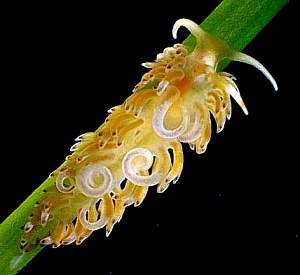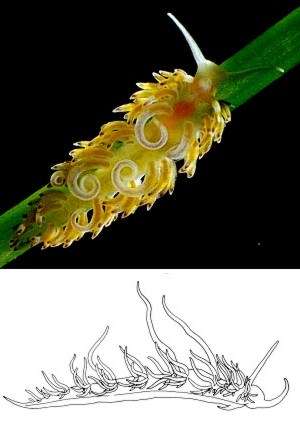

Phidiana salaamica
Rudman, 1980
Order: NUDIBRANCHIA
Suborder: AEOLIDINA
Family: Glaucidae
DISTRIBUTION
Known only from Tanzania and Kerama Island, southern Japan.
PHOTO
Kunduchi Bch, Dar es Salaam, Tanzania, August, 1973. On hydroids on seagrass, Syringodium. 13mm long alive (Holotype). PHOTO: Bill Rudman.
The cerata in Phidiana salaamica are very distinctive. In front of the pericardium the cerata are arranged in 4 or 5 slightly sloping rows. Behind the pericardium the ceratal are arranged in pairs of sloping rows, or at the posterior end, a few single rows. The most distinctive feature is that the innermost ceras in the posterior row of each ceratal cluster, is very elongate, and sits coiled over the dorsum. When the aeolid is threatened or disturbed, these enrolled cerata quickly unroll and become stiff and erect [See line drawing at right]. All other cerata stand out horizontally. Another animal with similar behaviour is Moridilla brockii.
The ceratal digestive gland duct ranges from an apricot yellow to orange-brown and the end of the gland in each ceras, below the cnidosac, is capped with reddish-purple.
Reference:
• Rudman, W.B. (1980) Aeolid opisthobranch molluscs (Glaucidae) from the Indian Ocean and the south-west Pacific. Zoological Journal of the Linnean Society 68: 139-172.
Rudman, W.B., 1999 (July 13) Phidiana salaamica Rudman, 1980. [In] Sea Slug Forum. Australian Museum, Sydney. Available from http://www.seaslugforum.net/factsheet/phidsala
